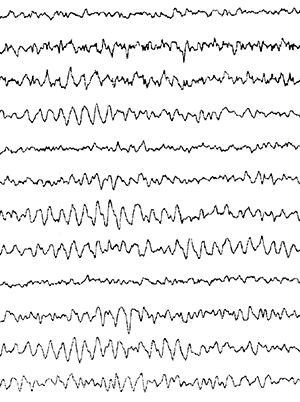A
B
C
D
E
F
G
H
I
J
K
L
M
N
O
P
Q
R
S
T
U
V
W
X
Y
Z
Click a letter to see a list of conditions beginning with that letter.
Click 'Topic Index' to return to the index for the current topic.
Click 'Library Index' to return to the listing of all topics.
Electroencephalography (EEG)
Electroencephalography (EEG) is a test that measures your electrical brain wave activity. Brain cells (or neurons) communicate through electrical signals. The EEG measures these electrical patterns. They show either normal or abnormal brain activity. The test is safe and painless.
 |
| Waveforms produced during an EEG |
What is EEG used for?
Your healthcare provider may order this test to check for seizures or other brain problems. For this test, several small metal disks (electrodes) are attached to the scalp with adhesives, or with water-based gel or paste. Your heart may be recorded with additional wires. During the test, wavy lines (waveforms) are recorded on a screen or on paper. Your provider will study these to assess your brain function. In some people who are prone to seizures, parts of this test may slightly increase their chance of having a seizure. Sometimes, you'll need to repeat an EEG while you are sleep deprived. During the test, you may be shown flashing lights. You may also be asked to take deep breaths multiple times during a short time period (hyperventilation). You may also be asked to go to sleep during the test.
EEG may be done in a doctor's office or a hospital lab. The test typically takes less than an hour, although much of the time is spent attaching the electrodes. Sometimes, the electrodes are left on for several hours or days so that the EEG test can record brain waves for a longer period of time. In these cases, you may need to stay in the hospital or can go home with a portable EEG recorder. The EEG may be recorded at the same time as a video of your movements. This is done to see if the electrical changes are related to the movements.
Before your test
Prepare for your test as instructed. Wash and dry your hair. But don't use any hairstyling products. Your scalp and hair should be clean and free of excess oil. Take your routine medicines, unless told not to. You may be asked to sleep during the EEG. To help you do this, you may be told to stay up all or part of the night before the test. Or you may be given medicine to help you sleep during the test. If so, someone will need to drive you home after the test. Your test will take about 60 minutes. Arrive with enough time to check in.
My next appointment is:
______________________________
For your safety and for the success of your test, tell the technologist about:
-
Any prescription or over-the-counter medicines, supplements, or herbs you take
-
Any seizures you may have had in the past
Online Medical Reviewer:
Anne Fetterman RN BSN
Online Medical Reviewer:
Luc Jasmin MD
Online Medical Reviewer:
Raymond Kent Turley BSN MSN RN
Date Last Reviewed:
7/1/2022
© 2000-2024 The StayWell Company, LLC. All rights reserved. This information is not intended as a substitute for professional medical care. Always follow your healthcare professional's instructions.